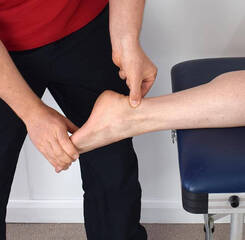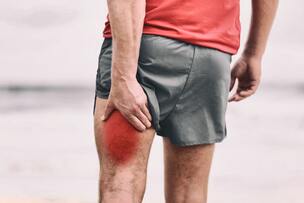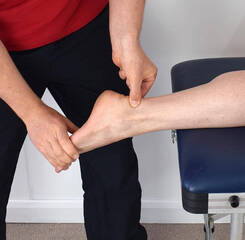|
There is no doubt that the human body can be very resilient. Short of regenerating new limbs, our bodies are capable of recovering from large amounts of damage, including broken bones. With this in mind, many people are happy to let nature take it’s course following an injury, thinking that seeing a physiotherapist will only act to speed up already healing tissues. The speed of recovery, however, is only one measure of healing and despite our body’s incredible capacity for repair, injury repair can be less than straightforward. Here are a few things about injury healing you may not have been aware of... 1. Scar Tissue is more likely to form without treatment.
Scar tissue can cause ongoing pain and stiffness in skin, muscles and ligaments. Physiotherapy can prevent excessive scarring from forming through advice regarding movement, massage and other hands-on treatment. 2. Your ability to sense the position of your body, known as proprioception, is often damaged after an injury and can be retrained. Impaired proprioception is a major factor in re-injury. If you’ve ever heard someone say “my knee/ankle/shoulder still doesn’t feel 100%” then this could be why. The good news is that with a specific exercise program, proprioception can be improved and restored. 3. Once healing has finished, your body may not be exactly the same as before. Following an injury, ligaments may be lax, joints may be stiffer and muscles are almost always weaker. While the pain may be gone, there might still be factors that need to be addressed to prevent more complicated issues in the future. 4. You may have picked up some bad habits while waiting for the injury to heal. While in pain, we often change the way we do things, this can lead to the development of poor movement patterns and muscle imbalances. Even though the pain has gone, these new patterns can remain and create further problems down the road. 5. Injuries don’t always heal completely. On occasion, injuries may not be able to heal completely on their own. The most serious example of this is a fracture that cannot heal if the bone is not kept still enough. Other factors that may prevent an injury from healing include poor circulation, diabetes, insufficient care of the injury and poor nutrition. Your physiotherapist can assess your injury and develop a treatment plan that will both restore you to the best possible function and prevent further injuries.
0 Comments
Many people know the value that physiotherapy brings to their life and some have even been visiting their physiotherapist since quite early in life. However, for those who have never been to see a physiotherapist before, there can be a question mark over exactly what it is that physiotherapists do. In fact, this is one of the most common questions we as physiotherapists are asked. What is the main job of a physiotherapist?
The answer is tricky, because physiotherapists do so much. Primarily, we might be described as pain management experts, as we work to reduce the pain of our patients, from those who have suffered a new injury, to those who have had pain for several years. We first identify the cause of the pain and then provide manual therapy techniques, education and management strategies to help our patient understand, manage and reduce their pain. While pain is usually the first thing that brings patients to see a physiotherapist, this pain has often caused patients to give up activities that they love and can even be getting in the way of everyday tasks. Many of us reduce our activity levels to reduce pain without even realising it. Physiotherapists are able to identify which areas you are struggling in and why this is occurring. By identifying the cause of your symptoms, we can help to get you back to full function. Physiotherapists are able to do this for everyone including elite athletes and those dealing with serious disabilities. In fact, physiotherapists have a role to play at practically every stage of life. Specialised paediatric physiotherapists can assess infants to monitor their motor skills development and as they grow we help them deal with the pains and vulnerabilities of a growing body. Among other things, we can help improve the function of athletes, assist in preventing injuries, help those with pelvic floor dysfunction and work to prevent falls in the elderly. Not just exercises and massage. Physiotherapists offer a range of treatments, from targeted stretches and strengthening exercises, manual therapies, dry needling, lots of advice on activity modification and massage. Physiotherapists are also committed educators and take our role as such seriously. A huge part of recovering from pain and injury comes from understanding what is happening and how to best manage these issues. Rather than create a dependency on their therapist, we aim to empower our patients to improve their health independently as much as possible. Physiotherapists aim to improve your quality of life and remove any barriers to full participation, whether these barriers are due to pain, weakness or stiffness. The decision to have surgery following an injury is a serious and complicated one. It can be difficult when navigating the minefield of information you receive to know what is the right pathway for you. Unfortunately, the answer is not always obvious which can be confusing. To ensure that surgery is right for you, here are a few questions it pays to ask yourself and your medical team before making a decision. How much will surgery cost and will I need to take time off work?
One of the major downsides of surgery is that you will often need to take time off work to recover, resulting in lost income. The cost of the surgery itself may not be completely covered by your insurance, particularly for elective procedures and you will often need to have physiotherapy afterwards. The cost of surgery can really add up, and if you can achieve similar results with physiotherapy alone, you might find yourself in a much better financial situation. What are the potential complications and success rates for your surgery? All surgeries come with risks and potential complications, the probability of these will vary depending on the type of surgery, your age and general health. It is also important to compare the success rates of surgery with a period of physiotherapy treatment. Optimal surgical outcomes still often depend on effective post-surgery management, which can be an argument for considering physiotherapy first. In some cases, however, healing simply will not occur without surgical intervention and physiotherapy will have little success in resolving the issue. What are your post-surgical goals? Not everyone wants to ski down a mountain, but for some, being able to push and trust their bodies is important for both their income and quality of life. Surgery that aims to repair damaged structures might be the right decision for someone who has high demands on their body, but not for another person who isn't very active. Setting your goals for your body can help to guide your decision making process. Before making any major decisions, it is important to consult your medical, surgical and physiotherapy team to ensure you are well educated in all the risks and rewards of undergoing surgery. Ankle sprains are extremely common, however this doesn’t make them easy to cope with when they happen to you. If you’ve ever spent two weeks hobbling around on crutches after a bad twist, you’ll understand just how painful and difficult they can be. What are they?
An ankle sprain refers to an overstretch or tear to the ligaments of the ankle. Commonly, a person will roll their ankle inwards and tear the ligament on the outside. Occasionally, the ankle will twist outwards and the ligaments on the inside of the ankle are torn and even less commonly, the fibres of the ligament that hold the two bones of the lower leg together can tear (this is a "high ankle sprain"). A sprained ankle will usually be painful, swollen, bruised, difficult to walk on and in some cases unstable. How does it happen? Ankle sprains can occur from something as simple as putting weight onto your leg when you think your foot is flat even though it’s not. The most typical pattern is of a person jumping and landing on the outside of their foot or simply slipping and twisting their ankle. A sprained or twisted ankle is one of the most common injuries presented to hospital emergency departments around the world. A medical or health professional should assess any ankle sprain. However, there are some guidelines to help decide if a sprained ankle needs an X-ray... 1. You are unable to put weight on the ankle immediately after the injury. 2. You are unable to take more than 4 steps immediately after the injury. 3. You have pain on the bony edges of the outer foot and ankle. How long do sprains take to heal? Depending on the severity of the tear, from one to six weeks. Your physiotherapist is able to help with recovery and ensure nothing slows down the healing process. Following any injury, joints may remain a little stiff and lose strength and control. Even though the injured tissues have healed, the ankle doesn’t move quite the way it used to. This means that your risk of twisting it again is higher than before the injury. How can physiotherapy help? Correct rehabilitation can help to speed up your recovery and prevent recurring injuries. As well as providing support to the unstable ankle, your physiotherapist will help you to strengthen any weak muscles and restore balance and control through exercise. They are also able to correct any abnormal movement of the joint following the injury. Seeing a physiotherapist is an important investment in your health and recovery from pain or injury. Here are a few tips to help get the best outcomes from your treatment sessions... 1. Know what your goals are and ask questions.
If you are clear on what you hope to achieve through physiotherapy, this can help you and your therapist to work together to direct treatment towards these goals. Understanding your condition also plays an important part in recovery, it means that you can make better choices to protect your body and and allow it to heal, and you will know better how to prevent future injuries. Before each treatment, it can help to take a few moments mentally to prepare some questions and consider what your short and long-term goals might be. 2. Do your exercises. Targeted home exercises are almost always an essential part of your recovery as they help your body to support itself through healing and recovery. Exercising is an important way to help correct biomechanical imbalances and reduce excess stress on body structures, as well as helping tissues to strengthen as they recover. 3. Follow your therapist's recommendations. Throughout your recovery, your therapist will guide you as to which activities you should avoid and how much rest to take. Return to sport and activity should be gradual, so as not to stress the body too much too soon when it is still healing. Rest is just as important a part of recovery as strengthening. Following the advice given by your therapist can ensure that you don't injure yourself again and that you get the most out of your body. 4. Be patient with your progress. It can be frustrating waiting for your body to heal. Returning to sport too early or giving up on treatment are common mistakes that lead to further injury or impaired healing. Recovery takes time, a general rule is often that the longer a condition has been present, the longer it will take to resolve. If there is a part of your condition or injury that you are struggling to understand, be sure to seek clarification with your physiotherapist. Two-way communication is key. Our muscles obviously play an important role in the movement of our body. Without them, we wouldn’t be able to bend our elbow or straighten our leg. As our muscles are soft and designed for flexibility, they are also prone to injury and if you have ever torn a muscle, you know that they can be very painful. In the period following a muscle tear, there are a few mistakes we often see people make that can make their injury worse and delay healing times. Here are a few of the most common mistakes we see... 1. Stretching
After a muscle tear, the damaged fibres slowly begin to heal and reattach to each other. This process can be quite fragile and during the early stages, aggressive stretching of recovering tissue can impair healing or even lead to more tearing. While gentle stretching a few days after the injury can have a positive effect, you should check with your physiotherapist to ensure you’re not stretching too far and causing further damage. 2. Applying H.A.R.M. Most of us are aware of the acronym R.I.C.E (rest, apply ice, compress the area and elevate) as the recommended treatment in the early stages of an acute injury. The acronym H.A.R.M is less well known and is used to remember the things you shouldn’t do after an injury. This stands for applying heat, drinking alcohol, running or massage. All of these activities can increase swelling, pain and increase the damage of the injury in the first 48-72 hours. 3. Failing to see a physiotherapist The diagnosis of a muscle tear might seem straightforward, however, there might be more going on than you realise. Many conditions can mimic a muscle tear, or you may have suffered a tear due to an underlying weakness or pathology. Having a physiotherapist confirm your muscle tear and identify any other issues is vital to ensuring you recover fully. Your physiotherapist is also able to identify any factors that could lead to further injury and is able to help restore your tissue to its previous level of strength and function. 4. Returning to sport too early One of the most confusing things about muscle tears is that they often become less painful while the tissues are still not completely healed. Many people suffer another tear simply because they return to sport too early. While you may feel as though your tissues are back to full strength, the muscle fibres can still be healing and vulnerable to further injury. It is important to test your injury gradually, starting with gentle exercise and building up to more high intensity activities. Your physiotherapist is able to guide you with a full rehabilitation program. This can help to restore strength, flexibility and control to your damaged muscle, keeping you injury free for the future. Many people already know the value that physiotherapy brings to their life, they may have had a physiotherapist with them through the highs and lows of injury and recovery more than once! However, for those who have never been to see a physiotherapist before, there can be a question mark over exactly what it is that physiotherapists do. What is it that physiotherapists do?
The answer is tricky because physiotherapists do so much. We might be described as pain management experts, as we work to reduce the pain of our clients, from those who have suffered a new injury to those who have had pain for several years. We first identify the cause of the pain and then provide manual therapy techniques, education, exercise and self-management strategies to help our patients understand, manage and reduce their symptoms. The pain or injury that motivates people to come and see us has often made them give up activities or sports that they love and can even be getting in the way of everyday tasks. By identifying the cause of your symptoms, we can help to get you back to full function. Physiotherapists are able to do this for people at all activity levels, including the general public, elite athletes and those dealing with serious disabilities. In fact, physiotherapists have a role to play at practically every stage of life. We can assess infants to monitor their motor skills development and as they grow we help them deal with the pains and vulnerabilities of a growing body. Among other things, we can help to prevent injuries, improve pelvic floor dysfunction and work to prevent falls in the elderly. Not just exercises and massage. Physiotherapists offer a range of treatments, from self-management strategies, stretches, manual therapies, dry needling, exercises and massage, to name a few. A huge part of recovering from pain and injury comes from understanding what is happening to you and how to best manage your issues. Rather than create a dependency on your therapist, we aim to empower our patients to improve their health independently as much as possible as well. A physiotherapist's primary goal is to improve your quality of life and remove any barriers to full function and participation in whatever you desire, whether these barriers are due to pain, weakness or stiffness. Can prolonged stress affect your pain and healing? Research now suggests that it can, particularly with chronic pain. If you suffer from ongoing pain you may have noticed this relationship yourself. Many people know that their pain is worse when they are stressed but they don't know why. Stress activates your sympathetic nervous system, this is the where we can move into "fight, flight or freeze" mode. The sympathetic nervous system is responsible for keeping us safe when we are in danger, however it can be activated for prolonged periods and many of us lack the skills to return control to our parasympathetic nervous system, which is responsible for helping us to "rest and digest".
How would this affect pain? During this state muscles become tense and ready for action, the nervous system is extra sensitive to stimulus, blood pressure is raised and we are more likely to notice and have negative thoughts. Tense muscles can become tired and sore or put extra stress on other structures, causing pain and irritation. Often when in a stressed state our breathing becomes shallow and rapid, even when not really exerting ourselves, such as while sitting in an office. Use your breathing to recover. An effective way to help your body return control to the parasympathetic nervous system is to consciously change your breathing. One method is to hold your breath for as long as you can, once you relieve your breath your body senses that a threat has passed and can return to a more relaxed state. Another commonly used technique is box breathing. To do this, breathe in for four seconds, hold for four, breathe out for four, hold again for four and repeat. Do this for a few minutes until you start to feel more relaxed and calm. Show your body that you are safe. Other activities that can help your body to relax include yoga, going for a swim or having a shower, or doing some intense exercise where your heart rate is raised. Speak to your physiotherapist for more information on this topic and tips to help you relax during the day. What are they? The hamstrings are a large group of muscles located at the back of the thigh. Their job is to bend the knee, extend the hip backwards and stabilise the leg. The muscles can be injured at any point along their length but are most vulnerable where the tendon and muscle fibres join together. This is a common injury for players of all sports that involve running, and particularly those that involve quick movements and kicking. What are the causes?
As the hamstrings cross two large joints (the hip and the knee), they need to perform complicated movements, often activating suddenly and with great force. They are often stretched during a fall, a powerful kick of a ball or a sudden take-off. Factors that increase the chance of a tear include poor flexibility, strength or neural mobility. Other factors that contribute to hamstring injuries are muscle imbalances, abnormal lower limb biomechanics, fatigue, and inadequate warm-up. The biggest predictor of a future hamstring tear though, is a previous hamstring injury. What are the symptoms? The most common symptom of a strained or torn hamstring is a sharp pain at the back of the thigh, often immediately after intense activity. There may also be swelling, bruising, difficulty walking and pain with knee movements. Your physiotherapist can confirm that the pain is due to injured hamstrings rather than any other issues, and tell you how bad the strain or tear is. Although not usually required, diagnosis can be confirmed by having an MRI or ultrasound scan. How can physiotherapy help? Once a diagnosis has been made, the first step is to follow the R.I.C.E protocol (Rest, Ice, Compression, Elevation). During the first 48 hours, you should apply ice for 20 minutes every one to two hours to reduce swelling and bruising. Consultation with your physio will include advice about your recovery, and when it is appropriate to return to sport. Your physiotherapist has many techniques that can promote healing and reduce scar tissue formation, which may include ultrasound, deep tissue therapy, electrotherapy and dry needling. Crucially, they will also prescribe you an exercise program to return strength, flexibility and control to your muscles, getting you back to your sport quickly and safely. Due to the high chance of recurrence, rehabilitation is very important and usually takes 6-12 weeks. If the muscle is completely torn, surgery may be required before rehabilitation can start. Your physiotherapist will work with you to help you set goals to get you back to your favourite activities as soon as possible. If you have ever suffered from a tendon injury you will know that the recovery can be frustratingly long. Tendons are important tissues of the body, connecting muscles to bones and come in many different shapes and sizes. There are many reasons why tendon injuries can be difficult to treat, as we explain below. Tendon injuries often develop gradually.
Tendons need to be able to transmit forces from muscles to the bones that they attach, however they respond to changes in strength more slowly than muscles do. As muscles become stronger or take on more load, the tendons can fail to keep up with this increased demand becoming painful and damaged. This process can take a while to occur and often changes to tendon tissue has begun long before the pain is noticed. This means that there are likely to be multiple factors to be assessed, including biomechanics and training regimes before the problem can be resolved. Tendons have limited blood supply. Tendons do have their own blood supply, however, it is not abundant as muscles and this can be a factor with healing as all tissues require nutrients for health and to heal. Any condition that compromises circulation, such as diabetes, can predispose tendons to injury and delayed healing. Rest and stretching may not necessarily help. Our instincts in response to tendon pain may not help with recovery. In some cases, stretching can aggravate symptoms and while rest may reduce symptoms, it will not necessarily help with recovery. The best evidence for promoting healthy tendon growth is through addressing poor biomechanics and a tailored strength and loading program. Recovery often relies on adherence to a specific rehab program. One of the biggest barriers to healing tendon pain is that exercises can be easy to do in theory, but hard to do in practice. They can take time and discipline. Your physiotherapist can also help you to find strategies to fit your exercises into your daily routine if you are finding this difficult. Ask your physiotherapist for more information about tendon pain! |
Categories
All
|











